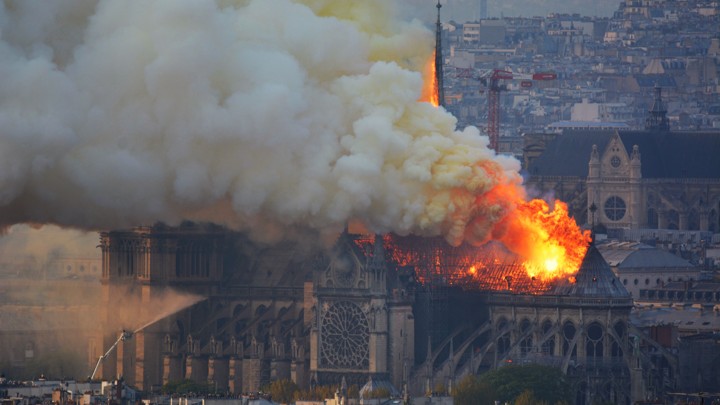The Buildings that Build Us Up: Mourning Notre Dame

Seeing the Notre Dame Cathedral in Paris engulfed in flames and smoke
had an unreal quality to it, even though fires and buildings catching on fire
are commonplace and very real. One of the thoughts that crossed my mind while
watching it was irritation at my past self for not having an interest in
traveling to France while I was studying abroad in Spain. My thoughts also
raced back to art history class in high school and seeing Notre Dame featured
so prominently in Bishop Barron’s Catholicism series. However, amid the horror
of the actual fire, what strikes me the most has been the deep sorrow
penetrating the hearts of Parisians, other French people, Catholics and all
lovers of art and architecture. World leaders, past and present, expressed
their condolences as a multitude of French people gathered in the streets of
Paris in silence and weeping. This event is a national tragedy indeed, and dare
I say, perhaps an international tragedy, which rightly deserves to be mourned.
The reason for
this requires some deeper reflection. Thinking back on the history of this
country, the September 11th terrorist attacks continue to stand as
the most prominent example of a national tragedy in recent times. Though the
Twin Towers did burn and fall, the principal source of national mourning was
the loss of thousands of human lives. I would contend that had the Twin Towers
fallen because of some industrial accident without the loss of human life,
there would have been a material loss but not necessarily national mourning.
Again, still speculating (and never having been to New York), I think the
destruction of the Statue of Liberty would produce a mourning more akin to what
we have seen in Paris because it carries within itself a deeper cultural and
human significance than a building constructed for economic utility.
At the same time,
the mourning for Notre Dame Cathedral goes deeper than its historical and
cultural significance for France and Europe in general. Those roots are deep,
and I do not want to insinuate that they are not significant enough in
themselves to merit mourning, because they are. However, the principal reason
to mourn Notre Dame, it seems to me, is that a sanctuary of the Lord has been
ravaged. This is a place where, for nearly nine centuries, the omnipresent God
has chosen to be with His people and be their Savior through the celebration of
the Church’s liturgy. God, by His very nature, exists outside of space and
time, but in His mercy and love for us, He chooses to encounter us in a
particular place and time. In The
Wellspring of Worship, Father Jean Corbon, O.P. beautifully writes that “the
church of stone or wood that we enter in order to share in the eternal liturgy
is indeed a space within our world; it is set apart, however, because it is a
space that the Resurrection has burst open. It is not a place that platonically
symbolizes an abstract universe, but a space in which a world delivered from
death really dwells” (191). Abbot Jeremy Driscoll, OSB of Mount Angel Abbey is
fond of saying that while one can pray and encounter God out in the woods, one
cannot receive the fullness of Jesus’ perfect self-offering to the Father
except through participation in the liturgy (paraphrase). Notre Dame, together
with all the great cathedrals and basilicas East and West as well as the most
humble urban chapel, is one of these blessed places where the reality of Christ’s
Paschal Mystery, which we celebrate in a solemn way this Holy Week, has been
communicated and received. Because of the structural damage, the future of
Notre Dame as a place where people encounter the living God in the liturgy
remains uncertain, which is tragic in itself. Let us pray with the people of
Paris that through the intercession of Notre Dame, this house of God may be
restored for the glory of the Lord and the salvation of the world.
Comments
Post a Comment